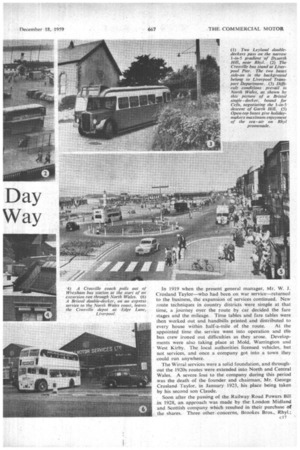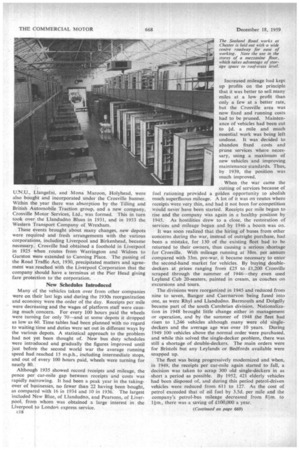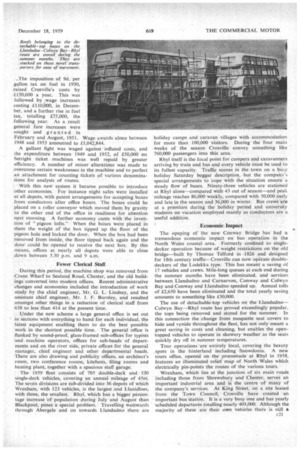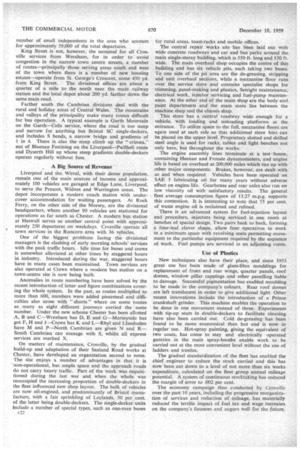Buses Saved and Paved
Page 54

Page 55

Page 56

Page 59

Page 60

If you've noticed an error in this article please click here to report it so we can fix it.
MORE than half a century ago,, when the motor industry was still in its infancy, George Crosland Taylor was responsible for the formation of the Crosville Motor Company, Ltd. His original intention was to assemble and sell French automobiles, and premises were rented at Crane House, Chester, for the purpose. It was not for some years, however4 until the company branched out into road passenger operation, that the venture prospered. In 1910 in order to bolster dwindling finances a bus service was inaugurated between Chester ahd Ellesmere Port with two charabanes, a Herald and an Albion. There was no direct rail route between the two towns and the public welcomed the innovation, which was quickly followed by services from Chester to Kelsall and between Nantwich, Crewe and Sandbach.
Between that period and 1947 many more routes were put into operation and 104 businesses purchased and added to the company's resources. On these foundations was built the present-day Crosville Motor Services, Ltd., whose fleet . of more than. 1,200 vehicles provides road passenger transport over an area of approximately 5,000 square miles in Cheshire, south-west Lancashire, North Wales, Anglesey and as far south as St. Doginaels in Cardiganshire, plus Liverpool-London express services. There have been many changes over the years, including the purchase of the original company, in 1929, by the London Midland and Scottish Railway Co: This was followed by membership of the Tilling and British Automobile Traction group and, in 1948, nationalization. Throughout the years, however, the name of Crosville and its traditions have been maintained. Mr. W. J. Crosland Taylor, son of the founder, has been with the company . since 1919 and was made general manager in 1935. , Mr. C. W. Catt and his family were originally share-b. holders in the limited company with Mr. George Crosland Taylor, but after financial losses they withdrew in 1910 and it became entirely a family concern. Soon after this,the late Mr. Claude Crosland Taylor became a member of the board and, by dint of hard work and gradual expansion, the annual losses were reduced until in 1914 the first modest profit of £1,302 was achieved. During the first world-war steady progress was made Crosville's contribution to the war effort included operation of bus services from the Mold and Flint areas taking workers to the new munitions factory at • Queensferry.
Traffic receipts rose during this period from £6,041 in .1914 to £27,522 in 1918. At this time the company were also interested in goads haulage and were -running Foden steam wagons with trailers, and Daimler lorries. A second side-line was the hiring out of farm tractors, and many hundreds of acres were cultivated by Crosville tractors drawing ploughs during war-time.
and the In 1919 when the present general manager, Mr. W. J. Crosland Taylor—who had been on war service—returned to the business, the expansion of services continued. New route techniques in country districts were simple at that time, a journey over the route by Car decided the fare stages and the mileage. Time tables and fare tables were then worked out and handbills printed and distributed to every house within half-a-Mile of the route. At the appointed time the service went into operation and the bus crew ironed out difficulties as they arose. Developments were also taking place at Mold, Warrington and West Kirby. The local authorities licensed vehicles, but not services, and once a company got into a town they could run anywhere.
The Wirral services were a solid foundation, and throughout the 1920s routes' were extended into North and Central Wales. A severe foss to the company during this period was the death of the founder and chairman, Mr. George Crosland Taylor, in January 1923, his place being taken by his second son Claude.
Soon after the passing of the Railway Road Powers Bill in 1928„ an approach was made by the London Midland and Scottish company which resulted in their purchase of the shares. Three other concerns, Brookes Bros., Rhyl.;
U:N.U., Llangefni, and Mona Maroon, Holyhead, were also bought and incorporated under the Crosville banner. Within the year there was absorption by the Tilling and British Automobile Traction group, and a new company, Crosville Motor Services, Ltd., was formed. This in turn took over the Llandudno Blues in 1931, and in 1933 the Western Transport Company of Wrexham.
These events brought about many changes, new depots were required and fresh arrangements with the various corporations, including Liverpool and Birkenhead, became necessary. Crosville had obtained a foothold in Liverpool in 1925 when routes from Warrington and Widnes to Garston were extended to Canning Place. The passing of the Road Traffic Act, 1930, precipitated matters and agreement was reached with the Liverpool Corporation that the company should have a terminus at the Pier Head giving fare protection to the corporation.
New Schedules Introduced
Many of the vehicles taken over from other companies were on their last legs and during the 1930s reorganization and economy were the order of the day. Receipts per mile were decreasing and the wages of platform staff were causing much concern. For every 100 hours paid the wheels were turning for only 70—and at some depots it dropped as low as 60. Time tables had been planned with no regard to waiting time and duties were set out in different ways by the various depots. A statistical approach to the problem had not yet been thought of. New bus duty schedules were introduced and gradually the figures improved until just before the second world war the average running speed had reached 15 m.p.h., including intermediate stops, and out of every 100 hours paid, wheels were turning for nearly 80.
Although 1935 showed record receipts and mileage, the pence per car-mile gap between receipts and costs was rapidly narrowing. It had been a peak year in the takingover of businesses, no fewer than 22 having been bought, as compared with 16 in 1934 and 10 in 1936: The largest included New Blue, of Llandudno, and Pearsons, of Liverpool, from whom was obtained a large interest in the Liverpool to London express service.
c18 Increased mileage had kept up profits on the principle that it was better to sell many miles at a low profit than only a few at a better rate, but the Crosville area was now fixed and running costs had to be pruned. Maintenance of vehicles had been cut to id. a mile and much essential work was being left undone. It was decided to abandon fixed costs and prune services where neces sary, using a maximum of new vehicles and improving maintenance standards. Thus, by 1939, the position was much improved.
When the war came the cutting of services because of fuel rationing provided a golden opportunity to abolish much superfluous mileage. A lot of it was on routes where receipts were very thin, and had it not been for competition would never have been started. Receipts per mile began to rise and the company Was again in a healthy position by 1945. As hostilities drew to a close, the restoration of services and mileage began and by 1946 a boom was on.
It was soon realized that the hiring of buses from other concerns during the war, instead of outright purchase, had been a mistake, for .130 of the existing fleet had to be returned to their owners, thus causing a serious shortage for Crosville. With mileage running at 38m. per annum compared with 33m. pre-war, it became necessary to enter the second-hand market for vehicles. By buying doubledeckers at prices ranging from £25 to £1,200 Crosville scraped through the summer of 1946—they even used Leyland Cub 20-seaters, painted in cream, as coaches on excursions and tours.
The divisions were reorganized in 1945 and reduced from nine to seven, Bangor and Caernarvon being fused into one, as were Rhyl and Llandudno. Barmouth and Dolgelly became part of the south Cambrian division. Nationalization in 1948 brought little change either in management or operation, and by the summer of 1948 the fleet had risen to 1,246 vehicles although many were old single deckers and the average age was over 10 years. During 1949 100 vehicles above the normal order were purchased, and while this solved the single-decker problem, there was still a shortage of double-deckers. The main orders were for Bristols but any Leylands or Bedfords available were snapped up.
The fleet was being progressively modernized and when, in 1949, the receipts per car-mile again started to fall, a decision was taken to scrap 300 old single-deckers in as short a period as possible. By 1952, 421 elderly vehicles had been disposed of, and during this period petrol-driven vehicles were reduced from 611 to 127. As the cost of petrol exceeded that of oil fuel by 3.5d. per mile and the company's petrol-bus mileage decreased from 81-rn. to 14m., there was a saving of £100,000 a year.
..The imposition of 9d. per gallon tax on fuel in 1950, .raised Crosville's costs by ..£150,000 a year. This was followed by wage increases costing £110,000, in Decem
ber, and a further rise in fuel tax, totalling £75,000, the following year. As a result general fare increases were sought and granted in February and August, 1951. Wage awards alone between 1948 and 1953 amounted to £1,042,844.
A gallant fight was Waged against inflated costs, and the expenditure between 1949 and 1952, of £50,000 on Setright ticket machines was well repaid by greater
efficiency. A: number of minor alterations was made to overcome certain weaknesses inthe machine and to perfect
an attachment for counting tickets of various denominations for analysis of routes.
• With this new system it became possible to introduce other economies. For instance night safes were installed at all depots, with patent arrangements for accepting boxes from conductors 'after office hours. The boxes could be placed on a roller conveyor which moved them by gravity to the other end of the office in readiness for attention next morning. A further economy came with the invention of " pigeon lofts." When the boxes were placed in them the weight of the box tipped up the floor of the pigeon hole and locked the door. When the box had been removed from inside, the floor tipped back again and the door could be opened to receive the next box. By this means, offices at nearly all depots were able to close down between 5,30 p.m. and 9 am, Fewer Clerical Staff
During this period, the machine shop was removed from Crane Wharf to Sealand Road, Chester, and the old buildings converted into Modern offices. Recent administrative changes and economies included the introduction of work study by the chief engineer, Mr. G. L. Lindsay, and the assistant chief engineer, Mr. J. F. Burnley, and resulted amongst other things in a reduction of clerical staff from 658 to less. than 414 at the present time.
Under the new scheme a large general office is set out in sections with everything to hand for each individual, the latest equipment enabling them to do the best possible work in the shOrtest possible time. The general Office is flanked by sound-proof, glass-framed sub-offices for typists and Machine operators, offices for sub-heads of departments and on the river side, private offices for the general manager, chief engineer and other departmental heads. There are also "drawing and publicity offices, an architect's room, two conference rooms, kitchens, filing rooms and heating plant, together with a spacious staff garage.
The 1959 fleet consists of 705 double-deck and • 530 single-deck vehicles, covering an annual mileage of 45m. The seven divisions are sub divided into 36 depots of which Wrexham, with 123 vehicles, is"the largest and Llanidloes, with three, the smallest. Rhyl, which has a bigger percentage increase 'of population during July and August than Blackpool, pokes a special problem. Travelling westwards through Abergele and on towards Llandudno there are holiday camps and caravan villages with accommodation for more than 100,000 visitors. During the four main • weeks of the season Crosville convey something like 760,000 passengers into this area.
Rhyl itself is the focal point for campers and caravanners arriving by train and bus and every vehicle must be used to its fullest capacity. Traffic scenes in the town on a busy holiday Saturday beggar description, but the company's special arrangements to cope with the situation ensure a steady flow of buses. Ninety-three vehicles are stationed at Rhyl alone—compared with 43 out of season—and peak 'mileage reaches 86,000 weekly, compared with 50.000 early and late in the season and 36,000 in winter. Bus crews are at a premium during the holiday period and university students on vacation employed mainly as conductors are a useful addition.
Economic Impact
The opening of the new Conway Bridge has had a tremendous economic impact on bus operation in the North Wales coastal area. Formerly confined to singledecker operation because of weight restrictions on the old bridge—built by Thomas Telford in -1826 and designed for 18th century traffic--Crosville can now operate doubledeckers of the Lodekka type. This has meant a saving of 17 vehicles and crews. Mile-long queues at each end during the summer months have been eliminated, and services between Llandudno and Carnarvon, Conway and Colwyn Bay and Conway and Llandudno speeded up. Annual tolls of £2,650 have been eliminated and the total yearly saving amounts to something like £30,000.
The use of detachable-top vehicles on the Llandudno— Colwyn Bay—Rhyl route has proved exceedingly popular, the tops being removed and stored for the summer. In this connection the change from moquette seat covers to hide and vynide throughout the fleet, has not only meant a great saving in costs and cleaning, but enables the opentopped vehicles to operate in showery weather as the seats quickly dry off in summer temperatures.
Tour operations are entirely local, covering the beauty . spots in the hinterland including Snowdonia. A new tours office, opened on the promenade at Rhyl in 1958, features an illuminated relief map of North Wales which electrically pin-points the routes of the various tours.
Wrexham, which lies at the junction of six main roads including those from Shrewsbury and Chester, serves an important' industrial area and is the centre of many of the company's services. At King Street, on a site leased from the Town Council, Crosville have created an important bus statiOn. It is a very busy one and has yearly 'scheduled departures totalling-nearly 403,000. Although the majority of these are their own vehicles there is still a
number of small independents in the area who account for approximately 59,000 of the total departures.
King Street is not, however, the terminal for all Crosvale services from Wrexham, for in order to avoid congestion in the narrow town centre streets, a number of routes—principally those serving areas south and west of the town where there is a number of new housing estates—operate from St. George's Crescent, some 450 yd.
from King Street. The divisional offices are about a quarter of a mile to the north near the main railway station and the local depot about 200 yd. farther dawn the same main road.
Farther south the Cambrian divisions deal with the rural and holiday areas of Central Wales. The mountains and valleys of the principality make many routes difficult for bus operation. A typical example is Garth Mountain on the Garth—Cefn service, where the road is too steep and narrow for anything but Bristol SC single-deckers, and includes S bends, a narrow bridge and gradients of 1 in 4. There is also the steep climb up the " crimea," out of Blaenau Festiniog on the Liverpool—Pwllheli route and Dyserth Hill up whose steep gradients double-deckers operate regularly without fuss.
A Big Source of Revenue
Liverpool and the Wirral, with their dense population, remain one of the main sources of income and approximately 100 vehicles are garaged at Edge Lane, Liverpool, to serve the Prescot, Widnes and Warrington areas. The depot incorporates a modern coach station with undercover accommodation for waiting passengers. At Rock Ferry, on the other side of the Mersey, are the divisional headquarters, where another 90 vehicles are stationed for operations as far south as Chester. A modern bus station at Heswall serves as another central point with approximately 250 departures on weekdays. Crosville operate all town services in the Runcorn area with 36 vehicles.
One of the biggest problems facing the divisional managers is the clashing of early morning schools' services with the peak traffic hours. Idle time for buses and crews is somewhat alleviated at other times by staggered hours in industry. Introduced during the war, staggered hours have in many cases been maintained. Town services are also operated at Crewe where a modern bus station on a town-centre site is now being built.
Anomalies in route numbering have been .solved by the recent introduction of letter and figure combinations covering the whole system. In the past, as routes multiplied to more than 600, numbers were added piecemeal and difficulties also arose with " shorts " where on some routes as, many as eight different journeys carried the same number. Under the new scheme Chester has been allotted A, B and C—Wrexham has D, E and G—Merseyside has got F, H and J—Crewe has K and L—Rhyl and Llandudno have M and P—North Cambrian are given N and R— South Cambrian can manage with S, whilst all express services are marked X.
On matters of maintenance, Crosville, by the gradual build-up and adaptation of their Sealand Road works at Chester, have developed an organization second to none. The site enjoys a number of advantages in that it is non-operational, has ample space and the approach roads do not carry heavy traffic. Part of the work was requisitioned during the last war and when the whole was reoccupied the increasing proportion of double-deckers in the fleet influenced new shop layout. The bulk of vehicles are now oil-engined, and predominantly of Bristol manufacture, with a fair sprinkling of Leylands, 50 per cent. of the latter being double-deckers. The single-decker units include a number of special types, such as one-man buses c22 for rural areas, toast-racks and mobile offices.
The central repair works site has been laid out with wide concrete roadways and car and bus parks around the main single-storey building, which is 550 ft. long and 150 ft. wide. The main overhaul shop occupies the centre of this building and has six vehicle pits, each taking two buses. To one side of the pit area are the de-greasing, stripping and unit overhaul sections, while a mezzanine floor runs over the service store and contains specialist shops for trimming, panel-making and plastics, Setright maintenance, electrical work, injector servicing and fuel-pump maintenance. At the other end of the main shop are the body and paint departments and the main store lies between the machine shop and the chassis shop.
This store has a central roadway wide enough for a vehicle, with loading and unloading platforms at the entrance. To utilize space to the full, mezzanine floors are again used at each side so that additional store bins can be placed on the upper level. Proprietary slotted and drilled steel angle is used for racks, tables and light benches not only here, but throughout the works.
The engine assembly lines terminate at a test house, containing Heenan and Fronde dynamometers, and engine life is based on overhaul at 200,000 miles which ties up with other major components. Brakes, however, are dealt with as and when required. Vehicles have been operated on SAE 5 lubricating oil for many years without adverse effect on engine life. Gearboxes and rear axles also run on
• low viscosity oil with satisfactory results. The general fleet average consumption figure of 13.27 m.p.g. supports this contention. It is interesting to note that 75 per cent. of waste engine oil is reclaimed and refined.
There is an advanced system for fuel-injection layout and procedure, injectors being serviced in one room at benches of special design. Two pairs back to back, forming a four-leaf clover shape, allow four operatives to work in a minimum space with revolving seats permitting movement to the particular equipment required by the sequence of. work. Fuel pumps are serviced in an adjoining room.
Use of Plastics
New techniques also have their place, and since 1953 great use has been made of glass-fibre mouldings for replacement of front and rear wings, quarter panels, roof domes, window pillar cappings and other panelling liable to damage. Successful pigmentation has enabled moulding to be made in the company's colours. Rear roof domes are left translucent in order to give additional light. Other recent innovations include the introduction of a Prince crankshaft grinder. This machine enables the operation to be done in one movement instead of three. Experiments with tip-up seats in double-deckers to facilitate cleaning have also been carried out. Cold de-greasing has been found to be more economical than hot and is now in regular use. Hot-spray painting, giving the equivalent of two coats, has come to stay and electrically operated gantries in the main spray-booths enable work to be carried out at the most convenient level without the use of ladders and trestles.
The gradual standardization of the fleet has enabled the chief engineer to reduce the stock carried and this has now been cut down to a level of not more than six weeks expenditure, calculated on the fleet group annual mileage potential. A system of continuous stocktaking has reduced the margin of error to .002 per cent.
The economy campaign thus conducted by Crosville over the past 10 years, including the progressive reorganization of services and reduction of mileage, has materially reduced the terrific impact of fuel tax and wage increases on the company's finances and augurs well for the future.












































































































